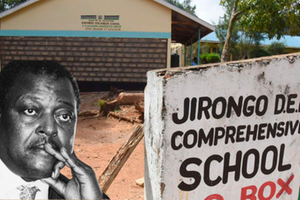Premium
Coronavirus is airborne, say US scientists in new report

A paramedic with Israel's Magen David Adom medical services carries marked containers at a drive-thru Covid-19 testing center in Jerusalem on October 7, 2020.
What you need to know:
- An American professor in June dismissed the social distance rule as not enough to give protection from Covid-19, saying it is based on old science.
- Dr Amoth noted that many Kenyans appear not worried about a second wave, which affects all age groups.
The virus that causes Covid-19 can be spread through air, even when people are more than 1.5 metres away from an infected person, the US Centers for Disease Control has said.
The revelation of airborne transmission underscores how easily it is for the virus to be transmitted and how it is increasingly important to continue wearing masks properly when in gatherings and even indoors with visitors.
After back-and-forth arguments on the mode of transmission, the CDC have now acknowledged that the virus can be transmitted even if the person is six metres away, particularly in poorly ventilated and indoor spaces.
“There is evidence that under certain conditions, people with Covid-19 seem to have infected others who were more than six feet away. It is possible that transmission can occur when one is breathing heavily or singing or even when exercising,” says the update.
An American professor in June dismissed the social distance rule as not enough to give protection from Covid-19, saying it is based on old science. The Massachusetts Institute of Technology researcher Prof Lydia Bouroiba said the “six-feet social distancing” recommendation was too close and that, to avoid the virus, people have to keep much farther — possibly eight metres.
Social distancing
“Although such social distancing strategies are critical in the current time of pandemic, it may seem surprising that the current understanding of the routes of host-to-host transmission in respiratory infectious diseases are predicated on a model of disease transmission developed in the 1930s that, by modern standards, seems overly simplified,” Prof Bouroiba says in her paper published in the Journal of the American Medical Association.
The CDC now says the virus can spread in small droplets or particles that linger in the air, potentially for hours after an infected person has left the space. “There is evidence that under certain conditions, people with Covid-19 seem to have infected others who were more than six feet away,” says the update.
“This is a wake-up call. If proven that people should put on their masks all the time. This is the only protection we have for now. I am saddened that most Kenyans are letting their guard down when we seriously need to take care,” said Health acting director-general Patrick Amoth.
Dr Amoth noted that many Kenyans appear not worried about a second wave, which affects all age groups.
“We have not started experiencing a second wave in the country but the day it will strike, then it will definitely become an emergency, going by what we are witnessing in other countries. No one will be spared. We have to continue putting on masks even when in the house with visitors,” he said.
"Many countries are talking about social distancing of six feet apart, and the advice people should wear masks only if they can't socially distance is really very poorly thought out in the context of aerosol spread. The CDC revelation makes it even more important for people to wear masks when indoors with people outside your household,” said Dr Robert Schooley, an infectious disease specialist at the University of California, San Diego.
Prof Bouroiba warns that besides the cough and sneeze droplets, people have to be wary of “turbulent gas cloud” that trap and carry the virus within them.
Warm atmosphere
“The locally moist and warm atmosphere within the turbulent gas cloud allows the contained droplets to evade evaporation for much longer than occurs with isolated droplets. Under these conditions, the lifetime of a droplet could be considerably extended by a factor of up to 1,000 from a fraction of a second to minutes,” says the professor, who studies the fluid dynamics of disease transmission.
The scholar says a powerful sneeze can send droplets flying more than the recommended two metres and that a gas cloud with the droplets can travel seven to eight metres adding that droplets that settle along the trajectory can contaminate surfaces, while the rest remain trapped and clustered in the moving cloud.”
The World Health Organization (WHO) was reconsidering emerging evidence indicating that Covid-19 can be transmitted through the air. According to the WHO, this form of transmission is limited to aerosol generating procedures such as endotracheal intubation, bronchoscopy, open suctioning, administration of nebulized treatment.





